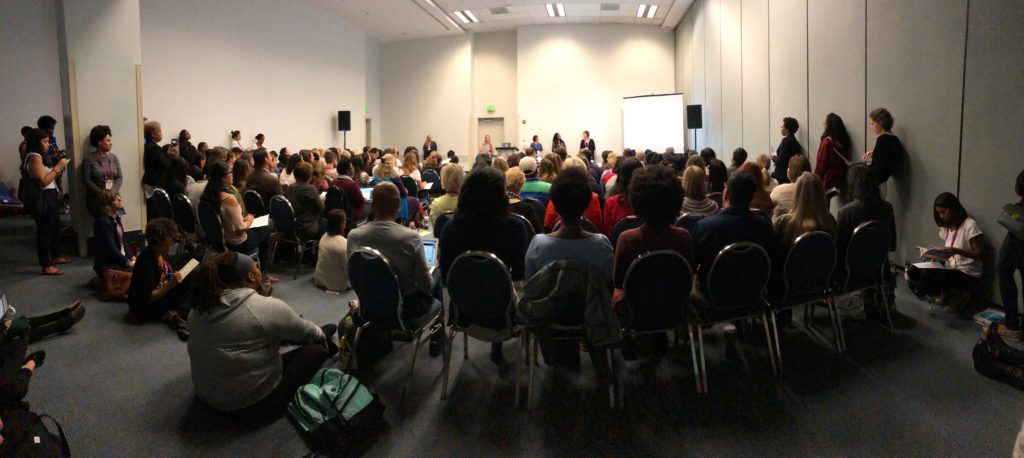
In 2016, our first grade teaching team launched an anti-bias education program to discuss biases with their first graders that has now circulated beyond The Children’s School!
The team, which includes Wilma, Amanda, Maryann, and Alison, led an incredible, standing-room-only workshop session for educators across the country at the 2017 National Association of Independent Schools People of Color Conference (NAIS PoCC) last November about the impact of using an anti-bias approach inside the elementary school classroom. The team shared the anti-bias education mission with the group: “instill in children love and respect for others that is stronger than hate and prejudice.”
“What we learned is that there’s a huge need for this kind of information for younger grades because our place was packed, standing-room only,” said Amanda.

Whether related to physical abilities and characteristics, gender, race and ethnicity, and family structure and socioeconomic class, children begin to notice differences as early as 3-years old.
“It’s important to do it at this age level because this is when the seed is planted. This is when we’re really talking about children developing behaviors and attitudes and personality behind what they believe and what they see,” said Wilma. “Home is the first learning place and school is pretty much the second one. Having that connection of what’s at school being transferred to home or what’s at home being transferred to school is rare. It’s all about cultural responsiveness.”
With this in mind, Wilma, Amanda, Maryann, and Allison shared resources on how to build an anti-bias framework for early elementary educators, and stories about reactions they’ve experienced from both children and parents.
The team covered the process of selecting books for the classroom that are inclusive and provided the audience with reading recommendations for educators and parents who want to learn more. The team also gave useful activities, age-appropriate language, and a plethora of children’s literature to support the challenges and opportunities when approaching biases with young children at their own schools.
The audience especially appreciated the team’s favorite anti-bias activities to use in the classroom and helpful tools for educators to develop their own curriculum plans.
“There was a reception because there was so much engagement; engagement in listening, engagement in body language, taking pictures, etc. They were like sponges in the room. There were so many people who have contacted us for bits and pieces of this information,” said Wilma.
Just this month, the team was invited to host a Skype session for the faculty at the Norwood School in Bethesda, MD around anti-bias education.
While many schools have an overarching goal to create a climate of positive self and group identity development, many still find it difficult to develop an immersive plan that efficiently covers each anti-bias pillar and/or get parents on board. “One more thing that’s come out of the whole experience is realizing how many people are actually struggling to do this work in their places of business,” said Wilma.
Anti-bias teaching in early elementary classrooms requires critical thinking and problem solving by both adults and children.
“Anti-bias education has become a large part of what makes my job meaningful. I believe strongly that our children will need the benefit of anti-bias curriculum as adults to interact with the people and world around them,” said Alison. “Each lesson is joyful when you see the children connecting the meanings, repeating key phrases that help them navigate their world, or considering a situation from another’s perspective.”
Maryann and Alison get parents involved in the conversations their children are having at school through “Talking Tuesdays.”
“Sometimes for homework there will be a question to ask a parent, like when’s a time that either they (the parent) showed bias or felt like someone else showed bias toward them,” said Maryann.
Another project Maryann and Alison do with their kids is the family oval project where parents work with their children to create their own family circle, instead of a tree, to help children recognize all the important people in their lives, regardless of what their family structure looks like. It also gives parents an opportunity to begin having difficult conversations around family, relationships, biology, and more.
What may seem difficult will become necessary and powerful in teaching our youngest learners. “Although children are not born with bias, they do learn differences at a very young age, so before they form a bias, plant the seed to work out how to shift the mindset and learn to respect others,” said Amanda.
This fall TCS will look at the intersection of race and gender in the middle school classroom with “My Authentic Self,” a conference for middle school students, faculty, administrators, and parents. Pollyanna, whose mission is to create a platform where groups of people can explore together diversity, equity, and inclusion, selected The Children’s School as its southeast partner to bring the conference to Atlanta-area independent schools.
We are honored to be chosen to host the conference,” said Director of Student Life and Inclusion Morgan Darby. “By bringing everyone together, we can engage in meaningful dialogue and form a community of schools who recognize that equity and inclusion are the centers of education – not the periphery.”









